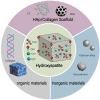Application of Hydroxyapatite Composites in Bone Tissue Engineering: A Review
- PMID: 40278235
- PMCID: PMC12028222
- DOI: 10.3390/jfb16040127
Application of Hydroxyapatite Composites in Bone Tissue Engineering: A Review
Abstract
The treatment of bone defects is complicated by clinical conditions, such as trauma, tumor resection, and infection, which result in defects and impair the bone's regenerative capacity. Hydroxyapatite (HAp), the primary inorganic component of bone, possesses good biocompatibility and osteoconductivity. However, it has poor mechanical properties, a slow degradation rate, and limited functionality, necessitating combination with other materials to broaden its application scope. This paper summarizes the importance and properties of HAp composites and provides a categorized review of current research on HAp composites in bone tissue engineering. These composite scaffolds not only offer excellent mechanical support for cell growth and tissue regeneration but also facilitate new bone formation and vascularization. Additionally, the challenges faced by HAp composites, such as material property optimization and improvement of preparation techniques, are discussed. The paper also summarizes the applications of HAp composites in bone defect repair, dental implants, spinal fusion, and other fields.
Keywords: bioactive ceramics; biocompatibility; biomaterial composites; bone repair; osteogenesis; scaffold.
Conflict of interest statement
The authors declare no conflicts of interest.
Figures
References
-
- Deplaigne V., Rochefort G.Y. Bone tissue engineering at a glance. AIMS Bioeng. 2022;9:22–25.
-
- Song J.E., Lee D.H., Khang G., Yoon S.J. Accelerating bone regeneration using poly(lactic-co-glycolic acid)/hydroxyapatite scaffolds containing duck feet-derived collagen. Int. J. Biol. Macromol. 2023;229:486–495. - PubMed
-
- Yuan X., Zhu W., Yang Z., He N., Chen F., Han X., Zhou K. Recent Advances in 3D Printing of Smart Scaffolds for Bone Tissue Engineering and Regeneration. Adv. Mater. 2024;36:e2403641. - PubMed
-
- Costa J.B., Pereira H., Espregueira-Mendes J., Khang G., Oliveira J.M., Reis R.L. Tissue engineering in orthopaedic sports medicine: Current concepts. J. ISAKOS. 2017;2:60–66.
Publication types
Grants and funding
LinkOut - more resources
Full Text Sources



